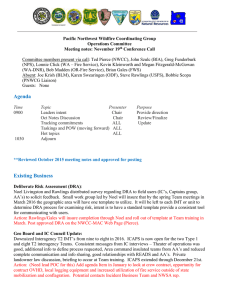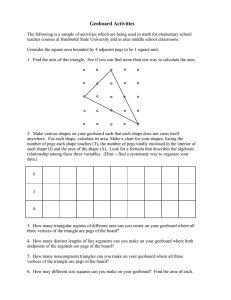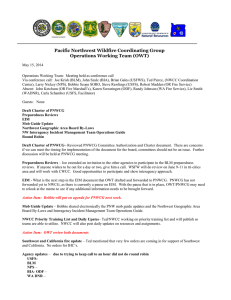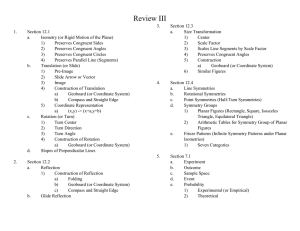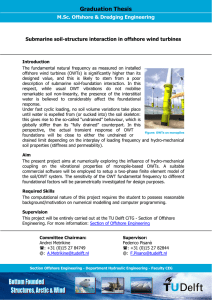Pacific Northwest Wildfire Coordinating Group Operations Committee
advertisement
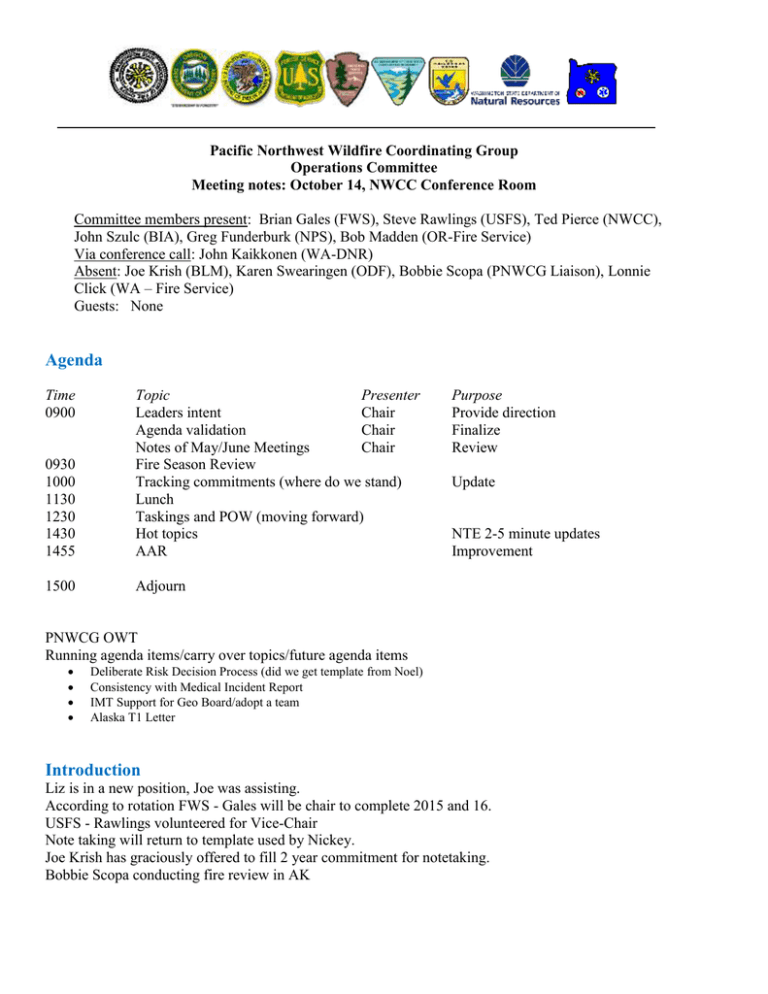
Pacific Northwest Wildfire Coordinating Group Operations Committee Meeting notes: October 14, NWCC Conference Room Committee members present: Brian Gales (FWS), Steve Rawlings (USFS), Ted Pierce (NWCC), John Szulc (BIA), Greg Funderburk (NPS), Bob Madden (OR-Fire Service) Via conference call: John Kaikkonen (WA-DNR) Absent: Joe Krish (BLM), Karen Swearingen (ODF), Bobbie Scopa (PNWCG Liaison), Lonnie Click (WA – Fire Service) Guests: None Agenda Time 0900 0930 1000 1130 1230 1430 1455 Topic Presenter Leaders intent Chair Agenda validation Chair Notes of May/June Meetings Chair Fire Season Review Tracking commitments (where do we stand) Lunch Taskings and POW (moving forward) Hot topics AAR 1500 Adjourn Purpose Provide direction Finalize Review Update NTE 2-5 minute updates Improvement PNWCG OWT Running agenda items/carry over topics/future agenda items Deliberate Risk Decision Process (did we get template from Noel) Consistency with Medical Incident Report IMT Support for Geo Board/adopt a team Alaska T1 Letter Introduction Liz is in a new position, Joe was assisting. According to rotation FWS - Gales will be chair to complete 2015 and 16. USFS - Rawlings volunteered for Vice-Chair Note taking will return to template used by Nickey. Joe Krish has graciously offered to fill 2 year commitment for notetaking. Bobbie Scopa conducting fire review in AK Old Business Deliberate Risk Assessment (DRA): Do we have an accepted template? Was it provided to ICs? Rawlings has access to template. Would like to have all of the PNW teams using the same format/process Consistency and Standardization provided for firefighters, IMT’s and AA’s. Survey to evaluate the effectiveness of Deliberate Risk Assessment format, Rawlings to get with Noel to distribute. . Survey says…Did you use it? How did it work? Were there any glaring holes or significant issues? Intent of Survey – list team and report how each process worked. Survey should provide information feedback towards developing a common format. Gales would like Ops. Committee or assigned lead to distribute adopted template. (Suggest having a session at team meetings to demonstrate process for utilization of the approved Deliberate Risk Assessment template) When compared to former risk analysis…Is it better? How is it better? Who is it for? What are we doing? Consistent process with teams provides a consistent process for the firefighter. Get rid of inconsistencies to bring credibility to the process. Consistency with deliberate risk assessment is vital for the buy in and understanding of the firefighter. Value: Identify abnormal hazards and mitigate task that are not SOP. Need to address through DRA: Where are we going to have severe accidents? Proposal: Send out survey to Ops. Comm. For feedback (IC Council) Idea to have discussion with IHC and IC Council –Rawlings Gales Survey sent to Ops. Committee, IC Council, and important operational groups (IHC, Module Leaders etc). Steve will take the lead on sending out the survey. Survey needs to provide link to current template PNWCG should approve final product and process. Need to pull PNW3 logo off of template. Ultimate goal of replacing with PNWCG logo. Realistically will not be able to work on this until January (with the exception of survey distribution) ACTION: Rawlings/Gales will touch base with IHC group and IC Council regarding DRA with a goal of having a product to present at the spring Team Meeting. Should put approved DRA on the NWCC-MAC Web Page Build ODF, Fire Marshalls and out of area IMT’s into process to further consistency. Alaska Team Letter: On hold until Bobbie returns from AK. Action for Bobbie to determine OWT role in bringing AK Teams into PNW rotation. What is the next step? Based on discussion with AK coordinating group. How is the OWT going to be engaged as we move forward? May choose to run this topic straight through the GeoBoard. 520 Nomination Process completed for 2016 Class: Action: Coordinate with GeoBoard, IC Council, OWT and Training Working Team to determine who takes ownership in 520 processes in order to stay ahead of needs. Who will be the lead in 2016? Announcement accomplished for 2015, submitted to Beams. Feedback is generally negative regarding 520 process. Need to improve this. No LOGS or FINANCE or IC nominations…How do we address this in future? Purpose and Focus of Operations Committee (OWT) Meeting in January to pull out charter and make sure we know what we need to focus on, what is important to us, and how can we best serve the firefighters. IPW Good consistency this summer, no significant issues raised. PNWCG / OPS LIASON Bobbie and Brian have been taking the lead and will continue. CHAIR DUTIES: Continue to farm out task based on interest and time. ALL HAZARD COMPLEXITY ANALYSIS AND MOBILIZATION: Type 3 Response more often than Type 1 or Type 2 Task Order (1410-02) for Type 2 Crew Requirements: Waiting for PNWCG to give specific direction and elaborate on task and its end state. ACTION: This has been lingering for over a year. Joe send Task Order to Gales New Business GeoBoard Update: (Szulc) Significant challenges from different missions, organizations, etc. Randy Johnson is Chair of Geoboard. 2016 Team meeting contract has been signed…March 30- April 1 @ Vancouver Hilton Theme will be: Resiliency IC Council has been asked to provide input for IMT Meeting. Need to invite more Line Officers to participate especially during AA breakout session with IC’s. GeoBoard reps. will attend IC Council Meeting. Steering Committee sent a letter regarding Type 2 capacity within Region. Geoboard would like to reduce to 8 Type 2 Teams. Why are we reducing to 8 teams? Not enough people to fill 9 teams. Cannot change ICAP system. Issues with how the announcement will be distributed…possible confusion in the way people will apply to teams. Need to prioritize agency personnel over ADs. GEOBOARD ACTION: Request steering committee draft letter to Line Officers requesting personnel be made available for team assignments. Will require cultural change. Culture of team will be based on ICs. All ICs are due for reapplication including Type 1 Teams. Expected commitment is 3 years for ICs and 1 year for all other Team members. Feedback to PNWCG. AAs need to give unedited feedback to teams for value. Transparent, constructive and honest feedback is essential. Significant discussion regarding keeping and holding teams under varying preparedness levels. Rotations: Is there a geographic distribution (north/south) or a single rotation. How will the teams be dispatched? (Locally or Geographic) GEOBOARD ACTION: What does dispatching look like with the new structure? IC Selections on November 4 in Vancouver. Announcements made by November 6. Team Selection on December 7 and 8. (When should the application open? Do we need to delay selections?) GEOBOARD approved roster published through ICAPS. Rosters may be adjusted outside of ICAPs by GEOBOARD through an approved process. This will avoid confusion created by reopening and reclosing ICAPS to supplement rosters with missing positions. Gales: One GEOBOARD is the right place to be, should stick with it. Will ultimately lead to being in a better place in the long run. Bob: This will be the first time the GEOBOARD has selected ICs. Fresh starting point with new IC selection. Will be living with the number of Teams being 8. Have to get past the ownership in the former team configuration. John: How do you message the reduction in Teams? This is a new opportunity with all of the ICs having to reapply. Should be seen as the reduction of total teams rather than standing down a particular team. ACTION: Who is going to administer the ICAPS program? Who is the contact for this workload? Is this a place the OWT can help? PNWCG PL5: FAST TEAM (John Kaikkonen) Ian Reed, USFS AA, Doug Frederick, USFWS, Ryan Staley, OAS, Jim Hearing, DNR Visited 7 incidents in 6 days with over 200 pages of notes. Asked to look at specific in-briefing items and produce a report Findings: IMTs and AAs use creativity etc. to protect Values at Risk with limited resources. Safety records good with tragic exceptions and notable near misses. Multiple fires not staffed due to inability to provide LCES. Independent action by landowners put firefighters at risk. AA support provided positive relationships with IMTs, but private landowners like working with local AAs. Critical shortage of Strike Team, Task Force etc. Communications infrastructure stressed due to large fire size. Report should be released soon… PNW Fire Season Summary (Ted) Handout on NW fire stats. Number of large fires consistent with 2014 PL 4 and PL 5 days higher than average. 56 Team mobilizations (High) 109 consecutive days with 1 or more teams in field. 11,450 firefighters engaged at peak activity. Competed well for receiving resources, but competition with other GACCs was noticeable. Task Order (See above) Is there anything out there with Contracting? Suggestion to have contracting folks provide and update and see if there are any concerns…Where do they need our help? Lots of effort was put into this, may be time to reevaluate. Opportunity to improve. This could be a good year to review the evaluation process and any changes that have been or need to be implemented. Are there trending performance issues? Medical Response Protocols IRPG pg. 108, NW 9 Line (In common use as a standard protocol) NO NEED TO ADDRESS Agency Updates or Concerns USFS: (Rawlings) Wildland Fire Modules Having the resources will reflect the need. Would be ordered more if they existed. Advantages: Self Sufficient MIST Experts (Modified Suppression Tactics) Special Applications (RAWS, Smoke monitoring, RXB2, long term implementation.) Need to educate TEAMs on capabilities and appropriate use. Type I vs. Type II Modules (Greatly differ in capabilities and qualifications) Should Pursue this as an Interagency Effort (Is there interagency funding available?) USFS and NPS are primary users. (Wilderness and Parks) Detail Opportunities on existing or new crews. (Enhance skillsets of other firefighters) BIA hiring first positions for a module, all federal agencies in room interested in participating on some level. POSSIBLE ACTION: Consider Briefing Sheet: Capability and Use of Wildland Fire Modules Type 3 Teams Out of area teams prepositioned several times during 2015 and generally utilized with good results. Use of local IMT3s sometimes drains local leadership. Suggestion for our GACC to provide IMT3s for out of area use. (SW or AK specifically) OWT could provide greater direction to local areas for development of IMT3s Skill level and capacity differs greatly amongst IMT3s. (By definition ISuite and other capabilities should be run through local agency.) Ops capabilities vary by individual experience levels. Should develop standard for IMT3 mobilization. IMT3 can be seen as a “starter kit” for larger incident management. Look at surge response to emerging incidents that have potential to become large fire cost incidents. Need Interagency Perspective ACTION: Develop Briefing Sheet: Standardization of IMT3s and Utilization outside of GACC. NPS: (Funderburk) Type 2 IA Crews Funderburk personally noticed concerns with Type 2 IA crews received via resource order. Are Agency and/or Contract crews meeting the standards? Are the standards being enforced? Do the standards need to be modified? BIA: (Szulc) BIA Regional Fuels Position Vacancy PL5: Smaller agencies have difficulty getting the appropriate resources. Out of GACC resources were being “hijacked.” Specific to severity resources being diverted en route. Finding balance between larger agencies with greater capabilities and smaller agencies trying to “deepen the bench.” Need to ensure that intent of severity resources and basic coverage is discussed as resources are being diverted to priority incidents. NWCC: (Pierce) Short Haul: Do firefighters and administrators fully understand the effort and exposure? How do we use short-haul aircraft? This is a tool that is becoming rapidly integrated into our operations. Is the availability of short-haul aircraft affecting our medical evacuation protocols? Is the availability of short-haul aircraft affecting our engagement of remote fires and reduce availability of these resources for tactical missions on fires. We need to discuss the mindset of working in remote locations. ACTION: White paper on educating firefighters on the use and expectation of Short-haul. Are all other options considered first (ground transport, heli-spot and etc.) USFWS: (USFWS) Sage Grouse not listed - will have future impacts on staffing levels and severity resource availability. November Meeting: Conference Call after IC Council Meeting November 19, 2015 @ 0900 OPERATIONS WORKING TEAM MEMBERS 2014/15 Operations Working Team (OWT) members: Joe Krish– BLM representative (Chairperson) Liz Smith – DNR representative (Vice Chairperson) Brian Gales – USFWS representative Karen Swearingen – ODF representative Steve Rawlings – USFS representative Randy Johnson – WA Fire Service representative Larry Nickey – NPS representative John Szulc – BIA representative Robert Madden - OR Fire Service representative John Ketchum – Ad Hoc member Bobbie Scopa – PNWCG Steering Liaison Carla Schamber – facilitator Ted Pierce – Dispatch Rep. 2016 Operations Working Team Members and Chair Order Brian Gales – USFWS representative (Chairperson) Steve Rawlings – USFS representative (Vice Chairperson) Karen Swearingen – ODF representative Lonnie Click – WA Fire Service representative Greg Funderburk – NPS representative John Szulc – BIA representative Robert Madden - OR Fire Service representative Joe Krish– BLM representative TBA – DNR representative Ted Pierce – Dispatch Rep. Bobbie Scopa – PNWCG Steering Liaison John Ketchum – Ad Hoc member End of Notes: G. Funderburk edited Gales 10.23.15
